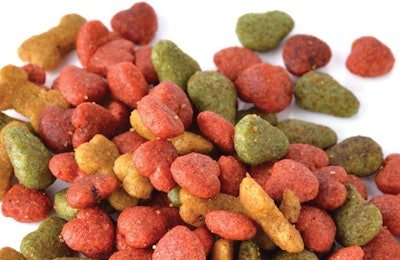
Pet food manufacturers can do several things to improve their working relationships with their color supplier, according to Katie Rountree of DDW - The Colour House, who spoke Tuesday at Petfood Forum’s Tech Talks in Kansas City, Missouri.
Because humans want to see the same things in their food as in their pets’ food, many pet food manufacturers are moving away from artificial and synthetic colors and transitioning to natural colors in their products. This means they need to find substitutions for the color products they use.
“The human trends are actually driving this force. So, as the human foods have started moving more toward those natural colors, pet foods are now starting to pick up those trends as well.”
She advised her audience to remember “PETS”:
- Provide your base
- Example color for matching
- Think about the cost/use rate parameters
- Set acceptable variances
Base basics
Rountree said manufacturers should provide their color supplier with a sample of their base material, or at least a recipe for it, along with processing parameters in order to best match the color they are currently using.
Target colors
When communicating target colors, the manufacturer should give the color supplier a sample of the current product for matching or refer to a product that is already on the market. In addition, providing colorimeter data and Pantone references can help achieve the target color more easily.
Define project parameters
Rountree said pet food manufacturers should set project parameters and cost-in-use limits in advance, as well as determining maximum use rates in their product. She advised companies to define their clean label list before choosing natural color substitutes so it is clear which ingredients are acceptable and which are not.
Determine deviation
When determining the deviation of colors from the target, manufacturers must set priorities, Rountree said. They should develop an acceptable variation, and several color options should be considered.













